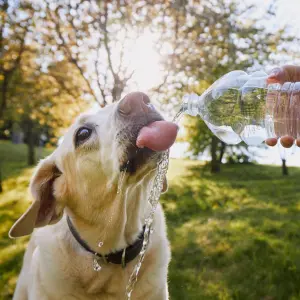Pet Drinking Water Quality
Water is a fundamental element in the health and happiness of our beloved pets. Just as with humans, the quality of the water our pets consume plays a pivotal role in their overall well-being. In this guide, we’ll explore the critical aspects of pet drinking water quality, from understanding their hydration needs to choosing the best water sources and maintaining clean water bowls.
Before delving into water quality, it’s essential to grasp the basics of pet hydration. Dogs and cats, like humans, require an adequate amount of water to stay healthy. Factors such as size, breed, and activity level influence their water needs. Contrary to popular belief, pets don’t always drink when they’re thirsty, making it crucial for owners to ensure a consistent and clean water supply.

The Impact of Water Quality on Pet Health
Ensuring the highest quality of water for your pets is not merely a matter of preference; it’s a critical aspect of responsible pet care. The composition of the water they consume has a profound impact on their health and can influence various bodily functions.
Water, even from seemingly clean sources, can harbor contaminants that pose health risks to pets. Common contaminants include bacteria, algae, heavy metals, and chemicals from agricultural runoff. These elements can lead to a range of health issues, from gastrointestinal problems to more severe conditions affecting organs and the nervous system.
Let’s explore the significance of water quality and its potential implications for the well-being of your furry companions.
Gastrointestinal Distress:
One of the most immediate effects of poor water quality is gastrointestinal distress. Contaminated water can cause nausea, vomiting, and diarrhea in pets. Chronic exposure to impurities may contribute to long-term digestive issues, affecting nutrient absorption and overall digestive health.
Kidney and Urinary Health:
Clean water is crucial for maintaining proper kidney function. Prolonged exposure to toxins in water sources can strain the kidneys and contribute to the development of kidney stones or urinary tract infections. Regular intake of clean water is vital for preventing these issues and promoting optimal urinary health.
Impact on the Immune System:
A compromised immune system can result from consistent exposure to waterborne contaminants. Pets that regularly consume water with impurities may become more susceptible to infections and illnesses. A robust immune system, supported by clean and quality water, is fundamental for overall health and longevity.
Skin and Coat Conditions:
Water quality plays a role in the external health of pets as well. Contaminants can contribute to skin irritations, allergies, and coat problems. Ensuring that your pets have access to clean water helps maintain healthy skin and a glossy coat, reflecting their internal well-being.
Neurological Effects:
Certain contaminants, especially those found in untreated or poorly treated water sources, can have neurological implications. Prolonged exposure may contribute to neurological disorders, affecting coordination, behavior, and overall cognitive function in pets.
While acute effects of poor water quality are readily noticeable, it’s essential to consider the potential long-term health implications. Chronic exposure to contaminants may contribute to the development of chronic diseases, reducing the quality of life for pets and potentially shortening their lifespan.
Understanding the potential impact of water quality on pet health underscores the importance of proactive measures. Regular water quality testing, especially if using well water, and investing in appropriate filtration systems are key steps in safeguarding your pets’ health. By being vigilant about water quality, pet owners can contribute significantly to the prevention of health issues and the overall well-being of their cherished companions.
Importance of Regularly Cleaning Water Bowls
Maintaining clean water bowls for your pets might seem like a straightforward task, but its significance cannot be overstated. The cleanliness of the water bowl directly impacts the quality of the water your pets consume and plays a crucial role in their overall health and well-being. Here’s why regular cleaning is an essential aspect of responsible pet ownership:
Preventing Bacterial Growth:
Water bowls can be a breeding ground for bacteria if not cleaned regularly. Residual saliva, food particles, and environmental contaminants can accumulate, creating an environment conducive to bacterial growth. Bacteria in the water can lead to gastrointestinal issues when consumed by pets, causing symptoms such as vomiting and diarrhea.
Avoiding Algae and Mold Formation:
Stagnant water in bowls, especially when placed in sunlight or warm environments, can promote the growth of algae and mold. Algae in the water may not only deter pets from drinking but can also introduce toxins into the water. Mold poses respiratory risks and can lead to allergies and other health problems in pets.
Ensuring Freshness and Palatability:
Pets, especially cats, can be quite discerning when it comes to the freshness and cleanliness of their water. Regular cleaning ensures that the water remains palatable and free from any unpleasant odors or tastes that might deter your pets from drinking enough to stay properly hydrated.
Preventing Biofilm Formation:
Over time, a slimy layer called biofilm can form on the interior surface of water bowls. Biofilm is a complex structure of microorganisms that can be harmful. Regular cleaning with pet-safe detergents helps prevent biofilm formation, ensuring that your pets are not exposed to potentially harmful microorganisms.
Reducing the Risk of Allergies:
Pets can develop allergies to mold, mildew, or even certain types of bacteria. Keeping their water bowls clean and free from contaminants reduces the risk of pets developing allergies that could lead to skin issues, respiratory problems, or other allergic reactions.
Establishing Healthy Drinking Habits:
Maintaining a clean water bowl encourages healthy drinking habits in pets. If the water bowl is consistently clean and appealing, pets are more likely to drink an adequate amount of water. This is particularly crucial for pets on dry diets, as proper hydration is vital for their overall health.
Simple Steps for Effective Cleaning:
Cleaning your pet’s water bowl doesn’t need to be a cumbersome task. Regular rinsing and washing with mild, pet-safe detergents, or even running them through the dishwasher, can effectively eliminate bacteria and prevent the accumulation of contaminants. Ensure thorough drying before refilling to prevent the growth of mold.
Signs of Dehydration in Pets
Understanding the signs of dehydration is paramount. Dogs and cats can’t communicate their needs verbally, so it’s up to pet owners to recognize symptoms such as lethargy, sunken eyes, and dry gums. Prompt action and, if necessary, veterinary care are crucial when dehydration is suspected.
Encouraging pets to drink more water involves creativity and consistency. Simple strategies, like adding ice cubes to their bowl or incorporating wet food into their diet, can make a significant difference. Making water appealing and readily available is key to maintaining optimal hydration levels.
Proper hydration is more than just a remedy; it’s a preventive measure. Adequate water intake contributes to overall preventive care, reducing the risk of urinary tract issues and other health concerns. Making hydration a priority is a proactive step towards ensuring a long and healthy life for your pets.
Conclusion
Pet drinking water quality is a cornerstone of responsible pet ownership. By understanding the intricacies of hydration, choosing the right water sources, and implementing simple yet effective strategies, pet owners can significantly contribute to the health and happiness of their furry companions. Stay informed, stay proactive, and ensure that your pets receive the high-quality water they deserve.



